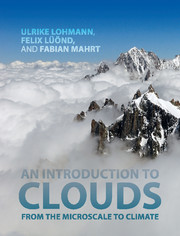Book contents
- Frontmatter
- Dedication
- Contents
- Preface
- List of symbols and acronyms
- 1 Clouds
- 2 Thermodynamics
- 3 Atmospheric dynamics
- 4 Mixing and convection
- 5 Atmospheric aerosol particles
- 6 Cloud droplet formation and Köhler theory
- 7 Microphysical processes in warm clouds
- 8 Microphysical processes in cold clouds
- 9 Precipitation
- 10 Storms and cloud dynamics
- 11 Global energy budget
- 12 Impact of aerosol particles and clouds on climate
- References
- Index
4 - Mixing and convection
Published online by Cambridge University Press: 05 June 2016
- Frontmatter
- Dedication
- Contents
- Preface
- List of symbols and acronyms
- 1 Clouds
- 2 Thermodynamics
- 3 Atmospheric dynamics
- 4 Mixing and convection
- 5 Atmospheric aerosol particles
- 6 Cloud droplet formation and Köhler theory
- 7 Microphysical processes in warm clouds
- 8 Microphysical processes in cold clouds
- 9 Precipitation
- 10 Storms and cloud dynamics
- 11 Global energy budget
- 12 Impact of aerosol particles and clouds on climate
- References
- Index
Summary
In this chapter we discuss the mixing of air masses (Section 4.1) and convection (Section 4.2). Mixing can either occur isobarically, i.e. at constant pressure, or adiabatically, when air parcels repeatedly move up- and downward. The isobaric mixing of different air masses can lead to fog formation when the air is sufficiently moist. In contrast, adiabatic mixing occurs when air parcels or air masses are mixed with the potential temperature constant. Adiabatic mixing can be observed when thermals rise from a hot surface in summer or when smoke from chimneys disperses.
Convection in the atmosphere refers to vertical motions of air parcels. Atmospheric convection may be divided into (i) (mechanically) forced convection and (ii) free convection, which is also referred to as thermal, gravitational or buoyant convection. An example of forced convection is the lifting of air along a cold or warm front or because of the orography. Here we are mainly interested in buoyant convection. This is best described in terms of the elementary parcel theory, which we will use to introduce the convectively available potential energy (CAPE) and the level of free convection (LFC). Because elementary parcel theory is rather simplified, its modifications, including entrainment, aerodynamic drag, compensating downdrafts and the weight of hydrometeors, are discussed at the end of this chapter.
Mixing
Isobaricmixing
Isobaric mixing provides one possibility for fog formation, creating the so-called “mixing fog”. Mixing fog is most commonly observed if warm and cold air is mixed, when both air masses are close to saturation with respect to liquid water. An example of mixing fog is “steam fog” (Figure 4.1), which can often be observed in autumn when cool air moves over warm water. When the cool air mixes with warm moist air over the water, the warm moist air cools. If its RH reaches 100% then condensation sets in and fog forms. Other examples of isobaric mixing occur when you see your breath on a cold winter day or the steam above a hot cup of tea.
Let us consider two air masses with mass, temperature and specific humidity given by m1, T1, qv1 and m2, T2, qv2. If these air masses are well mixed at constant pressure, we obtain a mixture that is the mass-weighted mean of their individual properties.
Information
- Type
- Chapter
- Information
- An Introduction to CloudsFrom the Microscale to Climate, pp. 95 - 114Publisher: Cambridge University PressPrint publication year: 2016
